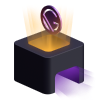Image-heavy photography portfolio with colorful accents & customizable pages. Includes adaptive image grids powered by CSS grid and automatic image integration into projects. Using the Gatsby Theme @lekoarts/gatsby-theme-jodie.
Also be sure to check out other Free & Open Source Gatsby Themes and my Personal Website.
- MDX
- Fully customizable through the usage of Gatsby Themes (and Theme UI)
- Create a project by creating an MDX file and dropping the images into the same folder
- Extensible custom pages
- Define colors for each page and the sidebar & content will adapt while maintaining WCAG 2 AA contrast ratios
- SEO (Sitemap, OpenGraph tags, Twitter tags)
- WebApp Manifest
Deploy this starter with one click on Netlify:
Use the Gatsby CLI to clone the site and install dependencies:
npx gatsby new gatsby-starter-portfolio-jodie https://github.com/LekoArts/gatsby-starter-portfolio-jodiecd gatsby-starter-portfolio-jodieStart the site by running npm run develop.
Your site is now running at http://localhost:8000!
If you want to learn more about how you can use a Gatsby starter that is configured with a Gatsby theme, you can check out this shorter or longer tutorial. The tutorials don't exactly apply to this starter however the concepts are the same.
Important Note: Please read the guide Shadowing in Gatsby Themes to understand how to customize the underlying theme!
This starter creates a new Gatsby site that installs and configures the theme @lekoarts/gatsby-theme-jodie.
Have a look at the theme's README and files to see what options are available and how you can shadow the various components including Theme UI. Generally speaking you will want to place your files into src/@lekoarts/gatsby-theme-jodie/ to shadow/override files. The Theme UI config can be configured by shadowing its files in src/gatsby-plugin-theme-ui/.
Edit the file at src/@lekoarts/gatsby-theme-jodie/icons/logo.jsx.
By default, the underlying theme and thus this starter uses "Work Sans" as its font. It's used throughout the site and set as a font-family on the html element.
If you want to change your default font or add any additional fonts, you'll need to change a couple of things:
- Font file inside
static/fonts - Preload link inside
gatsby-ssr.tsx(the name of the font file) - CSS in
global.css - The Theme UI config and its
fontskey (see Theme UI Typography Docs)
For the sake of this explanation it's assumed that you replaced "Work Sans" with "Roboto Mono".
Change the file src/gatsby-plugin-theme-ui/index.js with the following contents:
// Inside src/gatsby-plugin-theme-ui/index.js
import { merge } from "theme-ui";
import originalTheme from "@lekoarts/gatsby-theme-jodie/src/gatsby-plugin-theme-ui/index";
const theme = merge(originalTheme, {
fonts: {
body: `"Roboto Mono", monospace`,
},
});
export default theme;As defined in the Theme Specification body is the default body font family.
Another example: You didn't replace "Work Sans" but added "Roboto Mono" additionally since you want to use it for your headings.
Then you'd not overwrite body but add a heading key:
// Inside src/gatsby-plugin-theme-ui/index.js
import { merge } from "theme-ui";
import originalTheme from "@lekoarts/gatsby-theme-jodie/src/gatsby-plugin-theme-ui/index";
const theme = merge(originalTheme, {
fonts: {
heading: `"Roboto Mono", monospace`,
},
});
export default theme;Both your projects and pages are displayed on the homepage (located at / in the live project and src/components/homepage.tsx in the theme itself). Of course, you can always shadow this and other files to customize the theme to your liking.
However, before completely overriding the homepage you should consider the three available options:
homepagePageLimithomepageProjectLimit- Shadowing
modify-grid.ts
The options 1) and 2) are explained in the theme options -- they limit the number of projects and pages that will randomly be distributed on the page.
Option 3) is a really powerful one! The modifyGrid function is wrapping the entire array of projects & pages before passing it to the render function of the React component. Or in other words: As the name suggests you can modify the items that are passed to the grid on the homepage.
You can achieve this by shadowing modify-grid.ts: Create a file at src/@lekoarts/gatsby-theme-jodie/utils/modify-grid.js and define a default export for modifyGrid.
All code snippets are placed inside src/@lekoarts/gatsby-theme-jodie/utils/modify-grid.js
Default behavior:
const modifyGrid = (data) => data;
export default modifyGrid;I've also created some resolver templates that you can use. They are exported in resolver-templates.ts. They cover the most common use cases and can give you an idea on what to do with the resolver.
Only pages / Only projects:
import {
onlyPages,
onlyProjects,
} from "@lekoarts/gatsby-theme-jodie/src/utils/resolver-templates";
const modifyGrid = (data) => onlyPages(data);
// const modifyGrid = (data) => onlyProjects(data)
export default modifyGrid;Filter by slug:
import { filterBySlug } from "@lekoarts/gatsby-theme-jodie/src/utils/resolver-templates";
const modifyGrid = (data) => filterBySlug(data, ["/about"]);
export default modifyGrid;Shuffle:
import { shuffle } from "@lekoarts/gatsby-theme-jodie/src/utils/resolver-templates";
const modifyGrid = (data) => shuffle(data);
export default modifyGrid;The static folder contains the icons, social media images and robots.txt. Don't forget to change these files, too! You can use Real Favicon Generator to generate the image files inside static.
If you have general questions or need help with Gatsby, please go to one of the support platforms mentioned in Gatsby's documentation. If you have a specific question about this project, you can head to the GitHub Discussions of the repository.
Looking for more guidance? Full documentation for Gatsby lives on Gatsby's website.
To learn more about Gatsby themes specifically, I recommend checking out the theme docs.
-
For most developers, I recommend starting with the in-depth tutorial for creating a site with Gatsby. It starts with zero assumptions about your level of ability and walks through every step of the process.
-
To dive straight into code samples, head to Gatsby's documentation. In particular, check out the How-to Guides and Reference items in the primary navigation.
Thanks for using this project! I'm always interested in seeing what people do with my projects, so don't hesitate to tag me on Twitter and share the project with me.
Please star this project, share it on Social Media or consider supporting me on GitHub Sponsors!





